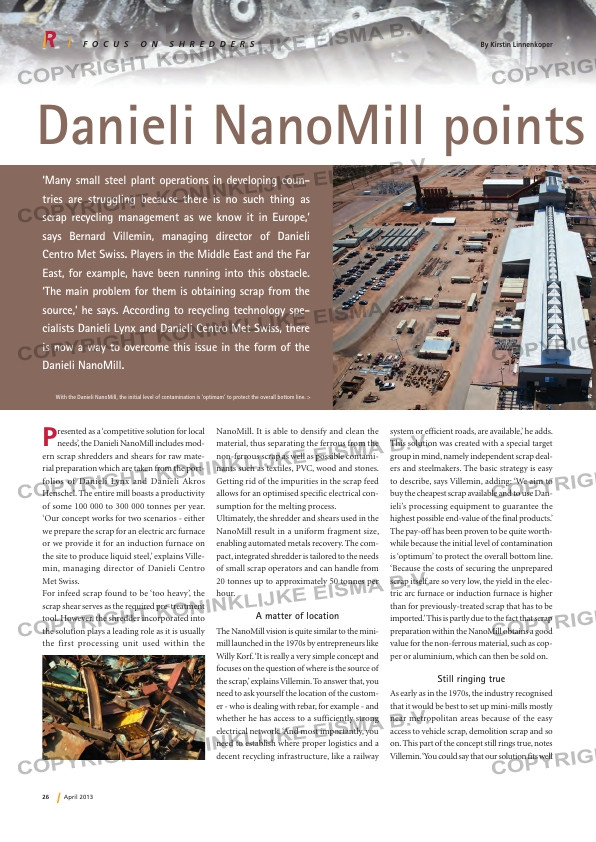Page 26 from: April 2013

26 April 2013
F O C U S O N S H R E D D E R S By Kirstin Linnenkoper
Presented as a ‘competitive solution for local needs’, the Danieli NanoMill includes mod-
ern scrap shredders and shears for raw mate-
rial preparation which are taken from the port-
folios of Danieli Lynx and Danieli Akros
Henschel. The entire mill boasts a productivity
of some 100 000 to 300 000 tonnes per year.
‘Our concept works for two scenarios – either
we prepare the scrap for an electric arc furnace
or we provide it for an induction furnace on
the site to produce liquid steel,’ explains Ville-
min, managing director of Danieli Centro
Met Swiss.
For infeed scrap found to be ‘too heavy’, the
scrap shear serves as the required pre-treatment
tool. However, the shredder incorporated into
the solution plays a leading role as it is usually
the first processing unit used within the
NanoMill. It is able to densify and clean the
material, thus separating the ferrous from the
non-ferrous scrap as well as possible contami-
nants such as textiles, PVC, wood and stones.
Getting rid of the impurities in the scrap feed
allows for an optimised specific electrical con-
sumption for the melting process.
Ultimately, the shredder and shears used in the
NanoMill result in a uniform fragment size,
enabling automated metals recovery. The com-
pact, integrated shredder is tailored to the needs
of small scrap operators and can handle from
20 tonnes up to approximately 50 tonnes per
hour.
A matter of location
The NanoMill vision is quite similar to the mini-
mill launched in the 1970s by entrepreneurs like
Willy Korf. ‘It is really a very simple concept and
focuses on the question of where is the source of
the scrap,’ explains Villemin. To answer that, you
need to ask yourself the location of the custom-
er – who is dealing with rebar, for example – and
whether he has access to a sufficiently strong
electrical network. ‘And most importantly, you
need to establish where proper logistics and a
decent recycling infrastructure, like a railway
system or efficient roads, are available,’ he adds.
This solution was created with a special target
group in mind, namely independent scrap deal-
ers and steelmakers. The basic strategy is easy
to describe, says Villemin, adding: ‘We aim to
buy the cheapest scrap available and to use Dan-
ieli’s processing equipment to guarantee the
highest possible end-value of the final products.’
The pay-off has been proven to be quite worth-
while because the initial level of contamination
is ‘optimum’ to protect the overall bottom line.
‘Because the costs of securing the unprepared
scrap itself are so very low, the yield in the elec-
tric arc furnace or induction furnace is higher
than for previously-treated scrap that has to be
imported.’ This is partly due to the fact that scrap
preparation within the NanoMill obtains a good
value for the non-ferrous material, such as cop-
per or aluminium, which can then be sold on.
Still ringing true
As early as in the 1970s, the industry recognised
that it would be best to set up mini-mills mostly
near metropolitan areas because of the easy
access to vehicle scrap, demolition scrap and so
on. This part of the concept still rings true, notes
Villemin. ‘You could say that our solution fits well
Danieli NanoMill points the way to the future
‘Many small steel plant operations in developing coun-
tries are struggling because there is no such thing as
scrap recycling management as we know it in Europe,’
says Bernard Villemin, managing director of Danieli
Centro Met Swiss. Players in the Middle East and the Far
East, for example, have been running into this obstacle.
‘The main problem for them is obtaining scrap from the
source,’ he says. According to recycling technology spe-
cialists Danieli Lynx and Danieli Centro Met Swiss, there
is now a way to overcome this issue in the form of the
Danieli NanoMill.
With the Danieli NanoMill, the initial level of contamination is ‘optimum’ to protect the overall bottom line. >
RI-3_RecyclingTechnology.indd 26 08-04-13 16:11



